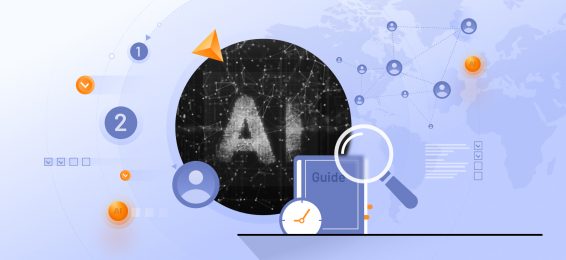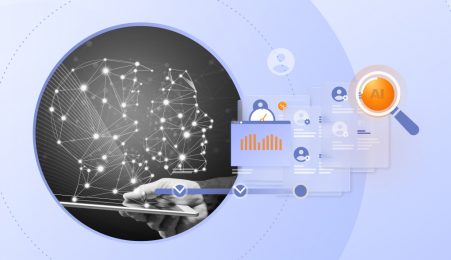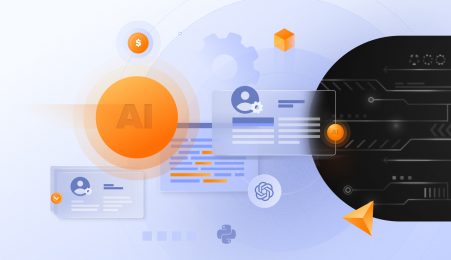Artificial intelligence is becoming the front and center of innovation in advertising and marketing. With the release of large-language models (GPT, LLAMA, etc.) and tools like Whisper, DALL-E, Stable Diffusion, and others, applications of AI in marketing are more accessible and helpful than ever.
Brands and agencies are exploring machine learning use cases for content creation and optimization, campaign management, and predictive analytics. AdTech platforms leverage AI to improve their offerings with state-of-the-art bid engines, audience segmentation tools, and more.
In this post, we will explore the most promising applications of machine learning in AdTech:
- Programmatic buying
- Contextual advertising
- Conversational platforms
- Generating content and visuals
- Designing audiences
- Traffic shaping
- Video management and distribution
Machine Learning in advertising: Market overview
The scale of machine learning algorithms for advertising is best understood through the lens of data. Here are the insights that depict the field and its overwhelming potential.
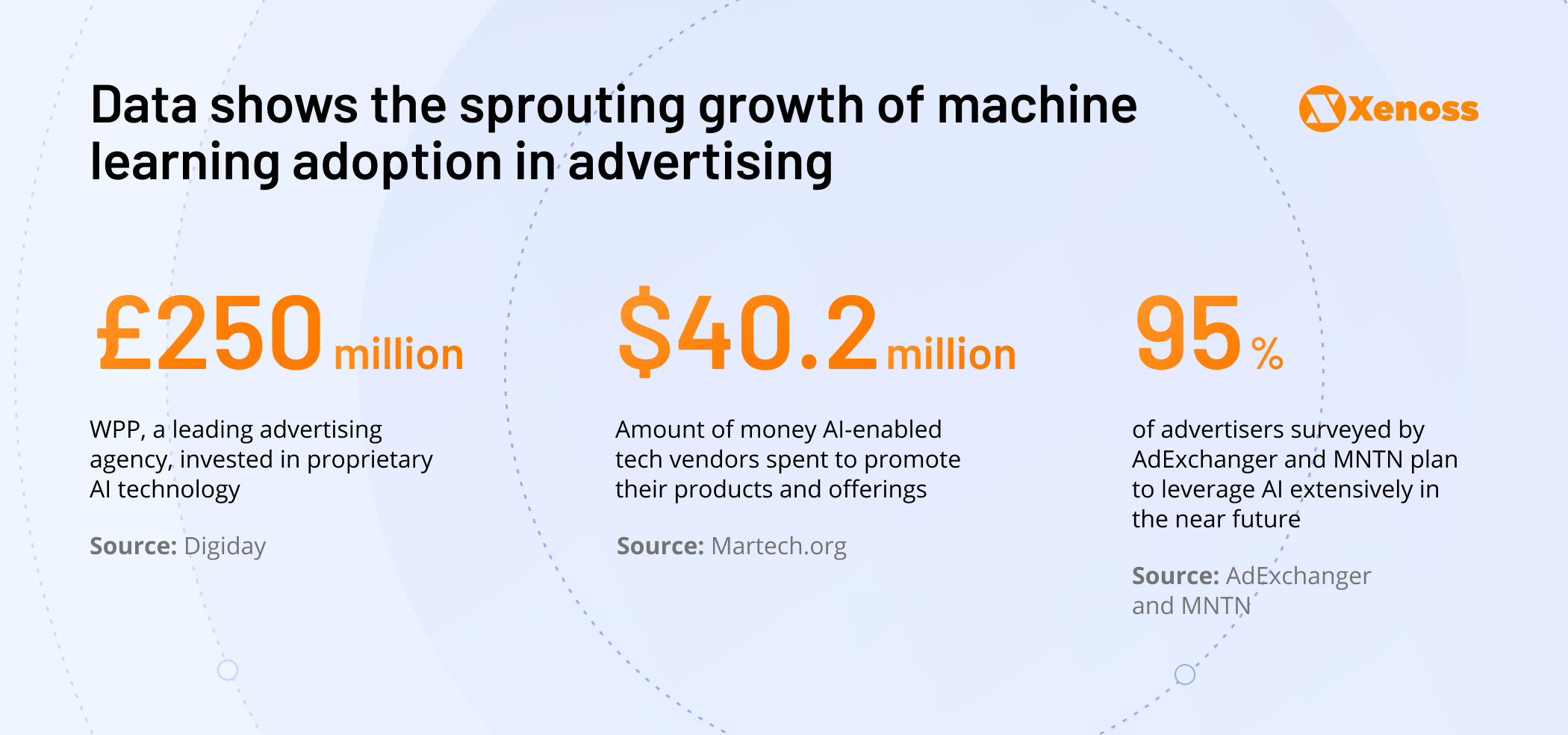
- Agencies are heavily investing in artificial intelligence: WPP is investing £250 million in proprietary technology to support data and AI in advertising
- Advertisers have spent $40.2 million to promote machine learning advertising products and solutions through September 2023 (Martech.org)
- Marketing and advertising professionals are betting on generative AI in the following order of preference: ChatGPT (75,2%), Bard (16,8%), Bing (16,6%), Midjourney (9.9%), Jasper (8.4%)
- 95% of advertisers out of 150 respondents surveyed by AdExchanger and MNTN say they plan to use machine learning for ads in the near future (The Impact of AI on Advertising, 2023)
The wide range of technologies under its umbrella makes machine learning applicable across all types of advertising processes — automated media buying, campaign management, content design, or measurement.
Moreover, as machine learning in advertising becomes more accessible, adding machine learning media buying features to AdTech software becomes a necessity rather than the luxury it used to be.

What ML models are used in AdTech?
Before exploring the applications of machine learning models in AdTech, let’s examine the approaches engineering teams use to train algorithms.
Broadly, they can be described as supervised, unsupervised, semi-supervised, and reinforcement learning. The critical difference between these strategies lies in the approach to preparing and processing datasets.
Supervised learning
Supervised learning refers to training a model on a set of structured and labeled data. As a result, the algorithm generates a function used to assess new data and create reasonably accurate predictions.

Applications of supervised learning in AdTech:
- Designing predictive audiences
- Customer segmentation
- Customer feedback analysis
- Predictive analytics
- Anticipating campaign performance
- Predicting customer sentiment
Why is supervised learning important for AdTech?
Supervised learning is the foundation of multiple features AdTech vendors use in their products. Capabilities like image and pattern recognition help improve the performance of creatives, guard against ad fraud, and build look-alike audiences. Agencies can also use supervised learning techniques like regression to help clients detect opportunities and make high-reward campaign investments.
At the same time, the high level of skills required for data filtering and structuring can be a caveat to supervised learning adoption. If data is not labeled correctly, the algorithm will be inaccurate.
Semi-supervised learning
Speed and cost are key limitations of supervised learning. Labeling data manually increases the time needed to develop a market-ready algorithm and the human resources required to process large data volumes manually adds to operating costs.
Semi-supervised learning was created as a way to address these challenges. This approach allows ML engineers to train the model on a smaller labeled dataset and then switch to training the algorithm on unlabeled data.
Semi-supervised learning applications in advertising
- Sentiment analysis
- Video and audio content analysis (these types of data are typically expensive to label)
- Identifying ad fraud patterns
- Classify web content by topics (could be applied to contextual targeting)
- Audience segmentation
- Lead scoring
Why is semi-supervised learning important in AdTech?
Semi-supervised learning techniques are implemented in AdTech products to increase personalization and improve the accuracy of campaign data analysis. Applications like target audience segmentation drive campaign ROI at a lower cost than traditional supervised techniques.
Likewise, semi-supervised learning can help advertisers find correlations between successful interactions, discovering similarities between successful leads that otherwise would’ve been missed.
Unsupervised learning
Unlike supervised learning, unsupervised learning does not rely on labeled training data. Instead, the model learns to find underlying patterns in raw inputs through clustering, dimension reduction, and other techniques.
The result is a probabilistic model teams can use to validate their hypotheses and data.
Unsupervised learning applications in advertising:
- Natural language processing. Unsupervised learning techniques like word vectors and associated models (skip-gram model and continuous bag of words) allow interpreting natural speech based on the context in which words are used.
- Recommendation engines. When it comes to content recommendation, data often has no labels, and the properties of each item are used to group similar articles, images, or videos.
- Tools for improved decision-making. Unsupervised learning techniques can help advertisers make sense of campaign data and identify trends and correlations in user behavior, high-yield ad placements, or best-performing formats.
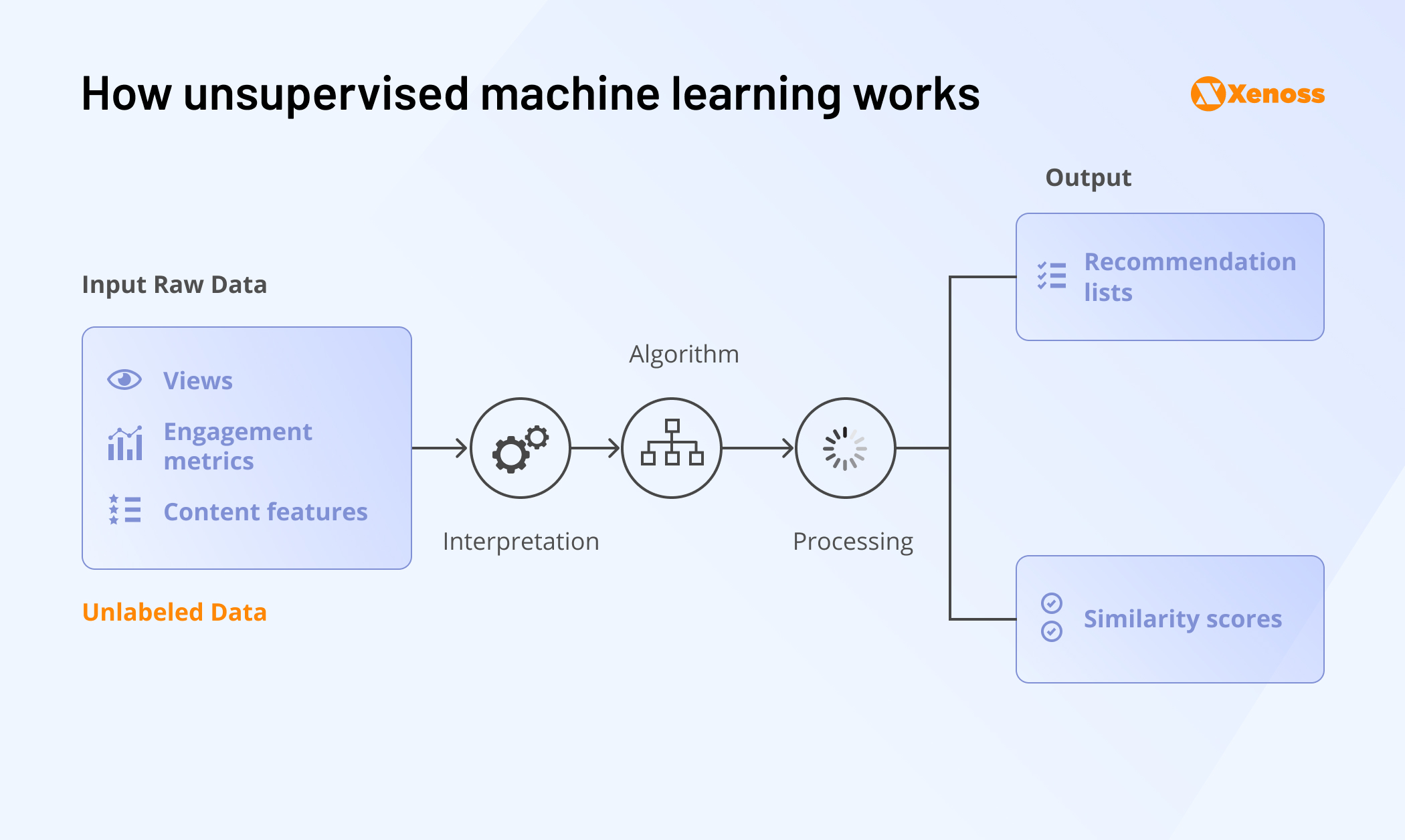
Why is unsupervised learning important for AdTech?
Unlike other approaches, unsupervised learning is the least resource-intensive approach, training-wise. It is typically easier to get unlabeled data, allowing AdTech vendors to cut time-to-market for their ML-enriched offerings.
The ability of USL techniques to group seemingly unrelated terms together can be maximized in AdTech. In our ecosystem, the ability to activate user data and make assumptions that are grounded in reality is vital. Autonomy and the ability to process different data types make unsupervised machine learning a helpful tool for assisting all types of AdTech decision-making.
It’s worth noting that unsupervised learning methods come with a heavy computational burden. When planning the deployment of an unsupervised model, tech teams should consider scalability challenges.
Where does deep learning enter the equation?
For the last ten years, deep learning has been riding the top of the hype cycle in AdTech and other industries. While it is a subset of machine learning, DL uses a unique approach to data recognition making it highly suitable for uncovering trends and common points between data sets.
As Hana Yoo put it in an AdExchanger article, “Whereas machine learning helps teach bots to copy human tasks, deep learning helps uncover trends, commonalities, and efficiencies.” The uniqueness of deep learning is in the ability to deconstruct a high-level object: a piece of text, image, etc. to its basic components and compare objects using these characteristics.
Deep learning algorithms process multiple raw data layers and extract high-level information. For example, a model can start its learning process by training on low-level details (identifying edges and curves) that increase in complexity until the algorithm can identify images (high-level representation of the data).
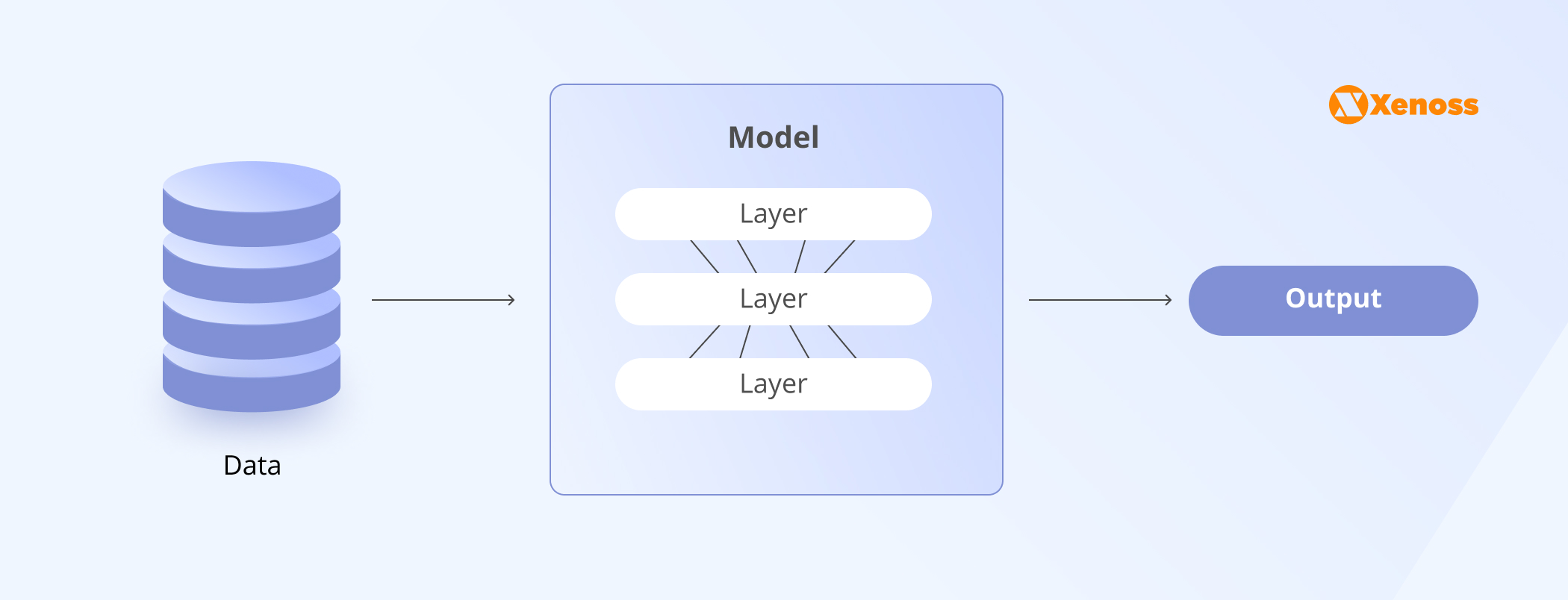
Applications of deep learning in AdTech:
- Improving the accuracy of contextual targeting
- Making real-time bid price predictions
- Generating content with large-language models
Why is deep learning important for AdTech?
Deep learning is coming to the industry at the best time possible—just as AdTech is entering the post-cookie era and dealing with the reality of privacy restrictions. These days, it’s getting harder to gather customer data unless it’s absolutely necessary, meaning we have to find better ways to use the information we have access to.
In this landscape, the sprouting growth of deep learning can help support the post-cookie transition, increase the personalization of ad creatives, and improve the precision of campaign planning.
Brands that leverage DL algorithms are already seeing the growth of traction. Data by Phrasee showed that AI-powered campaigns can help drive 275% ROI, a 23% CTR growth, and a 15% open rate uplift.
Reinforcement learning
Deep reinforcement learning (RL) contrasts supervised (training data is structured) and unsupervised (training data is not structured) learning approaches. This method requires the model to act in an unexplored environment.
Model-based reinforcement learning operates on the reward-and-punishment principle to discover optimal ways to achieve an outcome. Desired actions typically have a positive numerical value (reward), whereas a negative value is assigned to unwanted outcomes (punishment).
Reinforcement learning algorithms strive to complete a task with the highest numerical reward.
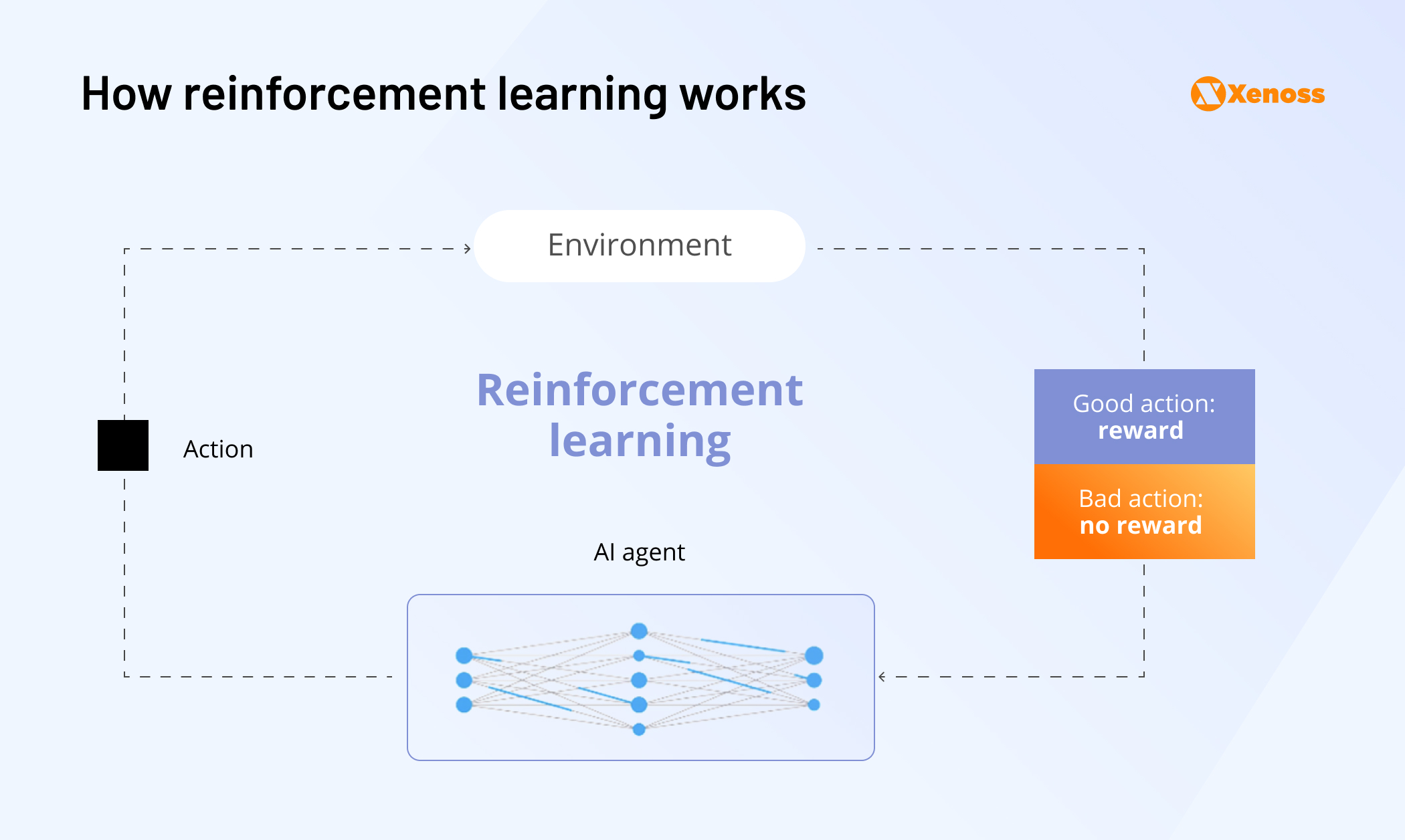
Reinforcement learning examples in AdTech:
- Personalization systems: Recent papers prove the utility of deep learning algorithms deployed in PyTorch and Caffe2 to help empower recommendation engines that outperform existing alternatives.
- Advanced A/B testing: Studies have shown that teams successfully leverage Python-based machine learning to track user interactions with forms and landing pages.
- Optimizing real-time bidding. Reinforcement learning AI papers show that multi-agent reinforcement learning techniques can help estimate the relevance of incoming bids, as well as help advertisers bid strategically to win their placements. The results published in the paper show that the cluster-based approach to bidding significantly outperforms single-agent or other approaches.
Why are reinforcement learning algorithms important for AdTech?
Deep reinforcement learning is another tool advertisers can use to make decisions in the absence of data. Deep reinforcement learning, similar to other models, can be the foundation of DCO, contextual targeting, and personalization.
Time is one of the key caveats to training Q learning models. It is difficult to know how many training steps a model will need to find an optimal solution to ask, making estimations becomes more challenging.
These subsets of machine learning support the bulk of AI applications in AdTech and MarTech. However, the full potential of Q learning algorithms is best understood when examining their use cases.
Below, we will examine how AdTech vendors leverage machine learning in their offerings.
Machine learning use cases in AdTech
AI has been part of AdTech discussions for a while—yet, for the most part, its impact was debatable. The industry deals with straightforward and rule-based operations and was easily getting by with statistical models without a pronounced need to implement machine learning.
The release of large-language models created a shakeup in the industry, showing that ML could significantly contribute to content generation and DCO. A 2023 survey conducted by AdExchanger and MNTN reveals that professionals in the AdTech industry are effectively utilizing machine learning to enhance their operations, with 92% reporting streamlined processes, 82% experiencing increased productivity, 59% seeing expanded creative capacity, and 50% achieving cost reductions.
Dhruv Ghulati, Applied AI Product at Uber, is hopeful for AI use cases in contextual advertising but cautious about the effects the cookieless transitions can have on implementations
Let’s look at machine learning applications in AdTech internally and from a user-facing perspective.

Programmatic buying

As the DSP ecosystem grows more robust, new tools are needed to navigate increasing data volumes and optimize performance. More teams are now using AI for price optimization and improving the quality of placements.
How AI is used in programmatic buying:
- Choose ad placements that fit the audience’s intent. AdTech vendors like Brightbid leverage machine learning to optimize bidding. The platform wraps around Google and Bing AI to help advertisers choose the right mix of long-tail keywords and audience combinations.
- Optimizing bid prices to maximize campaign ROI. Outbrain rolled out Engagement Bid Strategy (EBS) that uses machine learning to optimize bid prices and adjust prices to help advertisers reach engagement goals.
- Identify relevant metrics for tracking campaign performance. Acquisio offers teams ML tools to predict campaign outcomes and create detailed reports for performance tracking.
Contextual targeting
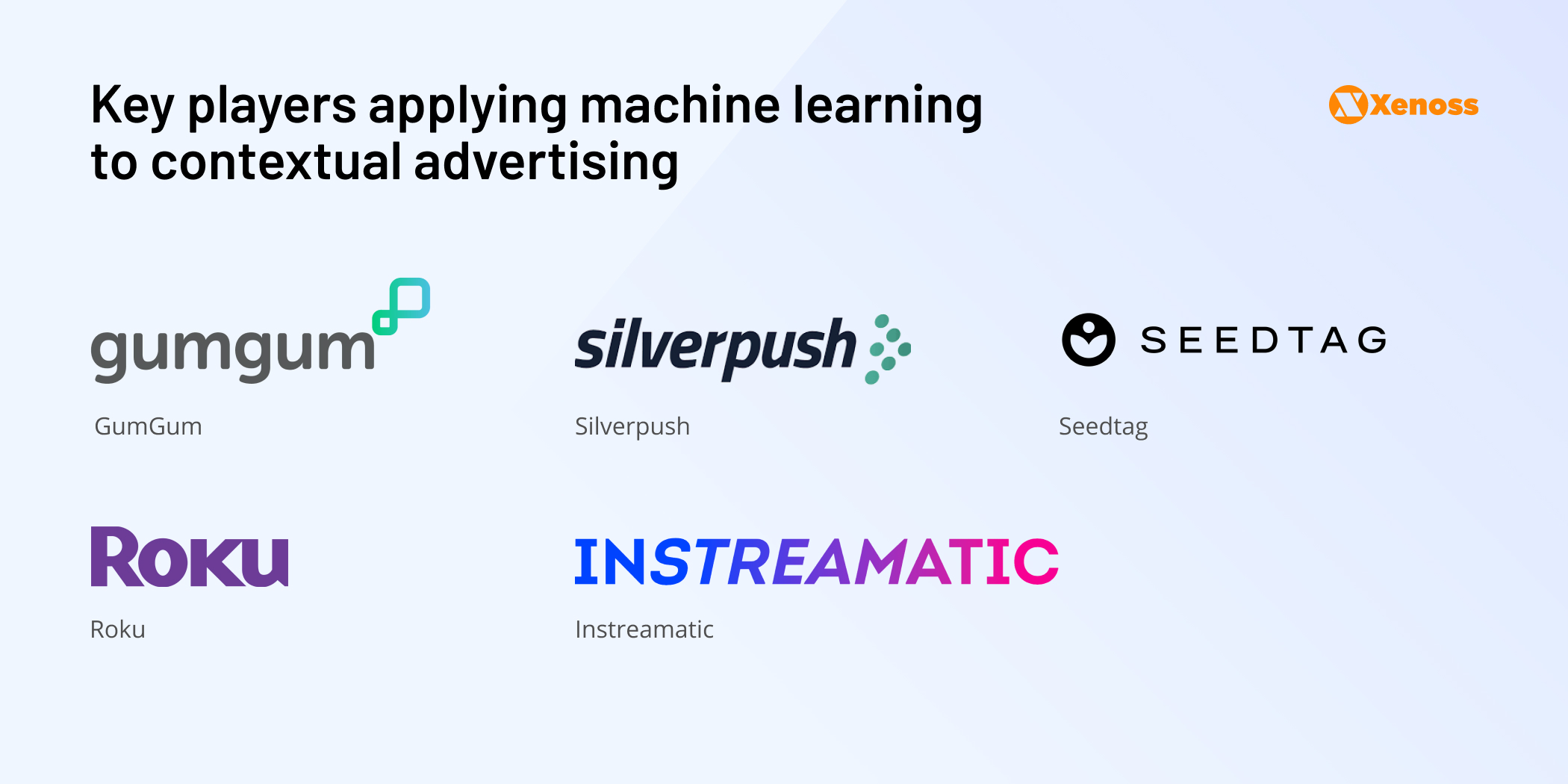
The sunset of cookies and strict privacy regulations fuel attention to contextual programmatic advertising. AI and machine learning have a broad range of applications, from gauging a reader’s intent to finding ways to place ads non-intrusively.
Applications of contextual AI:
- Placing ads in content that meets brand safety criteria. Mirrors by Silverpush is one of the examples of successful machine learning implementations for ensuring brand safety in contextual video targeting.
- Maximizing conversions through relevant placements. For example, Seedtag has a model trained on over 60 million articles to choose content that matches the ad’s tone, topic, and target audience.
- Determining the sentiment associated with an ad. Instreamatic leverages machine learning to help brands understand the context in which a video or audio will be interpreted by a viewer and drive conversions.
Conversational platforms

Generative AI tools based on natural language processing have revived the digital assistant concept and shown the power of their impact. Advertisers and publishers are now using chatbots to get accurate customer data, build relationships with their audiences, and guide customer interactions down the funnel.
Applications of AI in conversational advertising:
- Creating personalized customer interactions with digital assistant apps. IBM Watson Assistant is among the market leaders in offering ML-empowered customer interactions. The solution allows advertisers to have better control over the assistant’s knowledge base, tone of voice, and flow of interactions. For a more versatile experience, IBM is leveraging LLMs.
- Empowering conversational search. Andi is one of the leaders in the conversation search market. The platform uses generative AI to analyze the web and “cut straight to the knowledge”.
- Providing a deeper understanding of text-based or voice-based interactions with users. Quickchat, a no-code digital marketing assistant that allows advertisers and marketers to build custom chatbots, zeroes in on analytics, showing the number of messages per interaction, number of chats, interaction growth trends, and other helpful insights.
Generating content and visuals
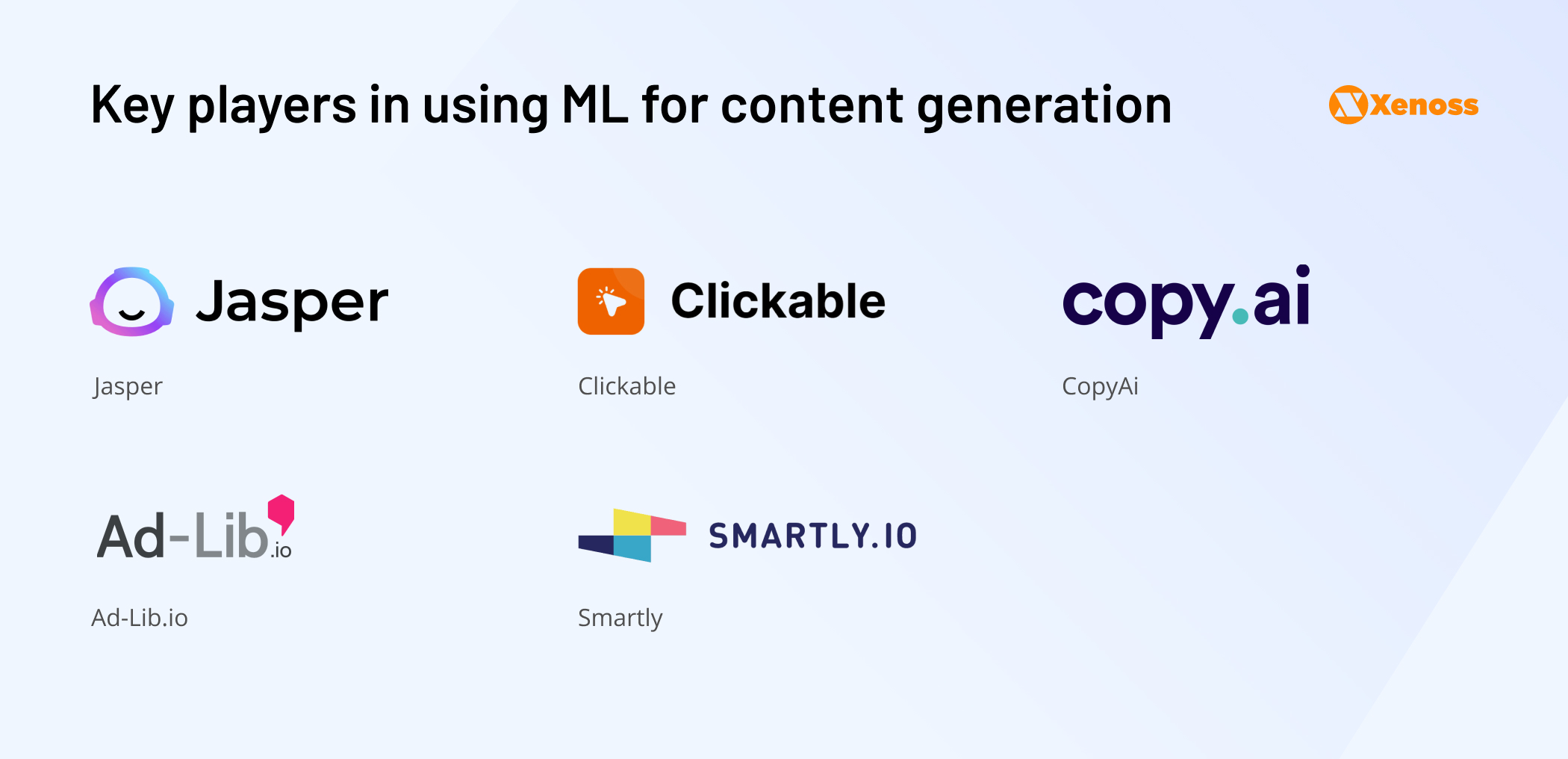
Content creation and optimization have been highly influenced by the growth of generative AI solutions. In the last year, thousands of text, image, and video generation tools entered the market, making ML-based content optimization universally accessible.
ML-based DCO solutions leverage data signals to predict an optimal mix of text and visuals that help drive engagement and conversion. For agencies and advertisers, AI-based content generation creates a powerful cost-reduction opportunity and a way to allocate creative resources efficiently.
Applications of machine learning in content generation:
- Generating copy tailored to narrow audiences or specific campaigns. Tools like Phrasee deploy generative AI to create copy that matches the audiences’ interests and aligns with the brand’s tone of voice.
- Optimizing creatives to different segments based on geographical, behavioral, and other variables. Ad-Lib.io, a DCO platform developed in partnership with Xenoss AI engineers, was one of the pioneers in AI-driven creative optimization. The tool leveraged machine learning models to help creative teams choose visuals that grab the attention of target audiences and optimize ads at scale.
- Detecting common patterns in an ad creative that lead to higher success rates of a programmatic advertising campaign. Tools like Pathmonk Intelligence use machine learning to predict the performance of ad campaigns.
Designing audiences
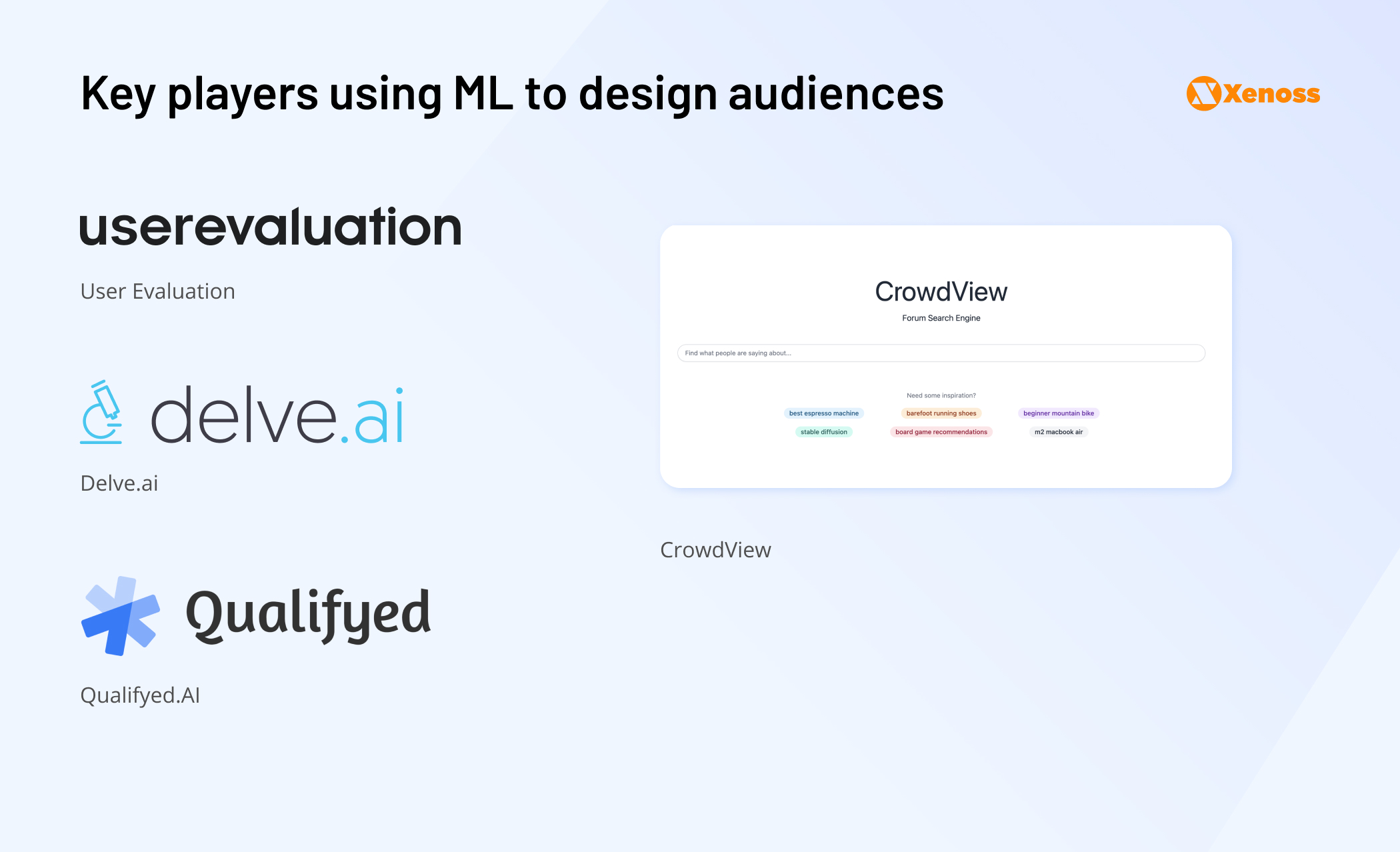
Machine learning has the potential to drive the evolution of targeted advertising. Where look-alike audiences were limited to grouping people based on similar characteristics, predictive audiences can create segments by grouping people who are likely to act in a similar way.
By understanding that people with similar characteristics do not act alike and identifying reliable behavioral markers, ML-enabled tools can help drive advertisers to drive engagement.
Applications of machine learning in designing predictive audiences:
- Detailed audience profiling through predictive analytics. Qualifyed AI uses machine learning to build predictive audiences. The platform uses machine learning to help advertisers activate first-party data and build lookalike audiences.
- Optimizing targeting budget, revenue, and ROI. There have been cases of publishers successfully predicting ad revenue on their new game through a predictive machine learning model.
- Defining a set of metrics to measure the relevance of curated audiences. Delve.ai uses machine learning to provide more depth to audience research by analyzing metrics like engagement, topics of interest, number of interactions with the brand, etc.
Traffic shaping

Bid request duplication strains the AdTech infrastructure, pushing vendors to process trillions of queries. To filter duplicated requests without missing out on lucrative bids, AdTech vendors use traffic shaping.
This practice leverages machine-learning models to predict the likelihood of buying. When a bid enters the system, an algorithm assesses its value based on the data points attached to requests. The bid’s value to the DSP is then assessed, and a request is processed or filtered.
Applications of machine learning in traffic shaping:
- Analyzing historical data and real-time inputs to predict the value of each ad impression. Twitter reported using machine learning models to predict the value of ad inventory.
- Utilizing predictive analytics, machine learning enables dynamic allocation of ad inventory.
- Refining traffic shaping strategies, improving targeting precision and overall campaign ROI. GumGum is the pioneer in using ML in traffic shaping. In the video below, we discussed how the company uses machine learning to filter bids.
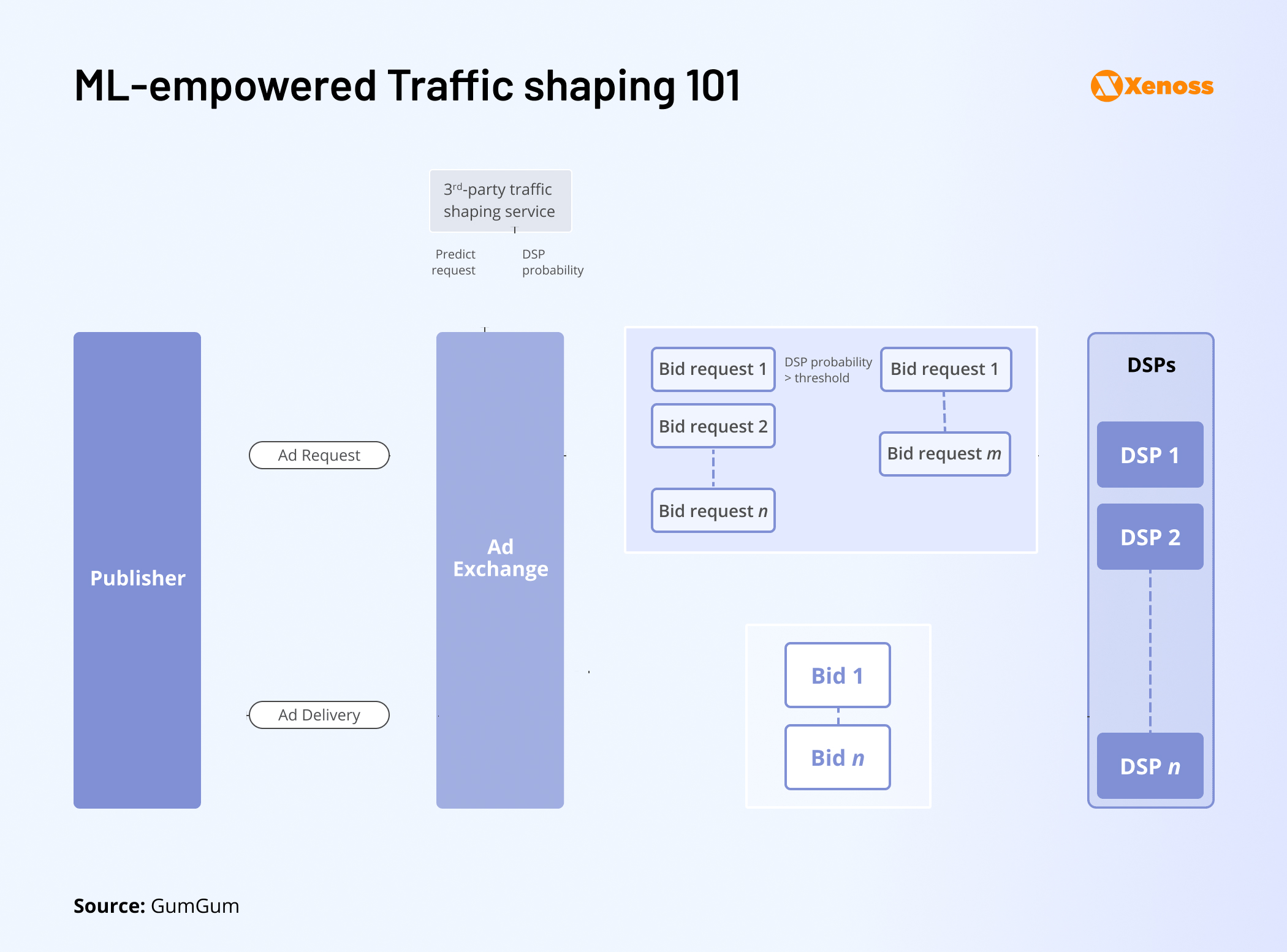
Video management and distribution
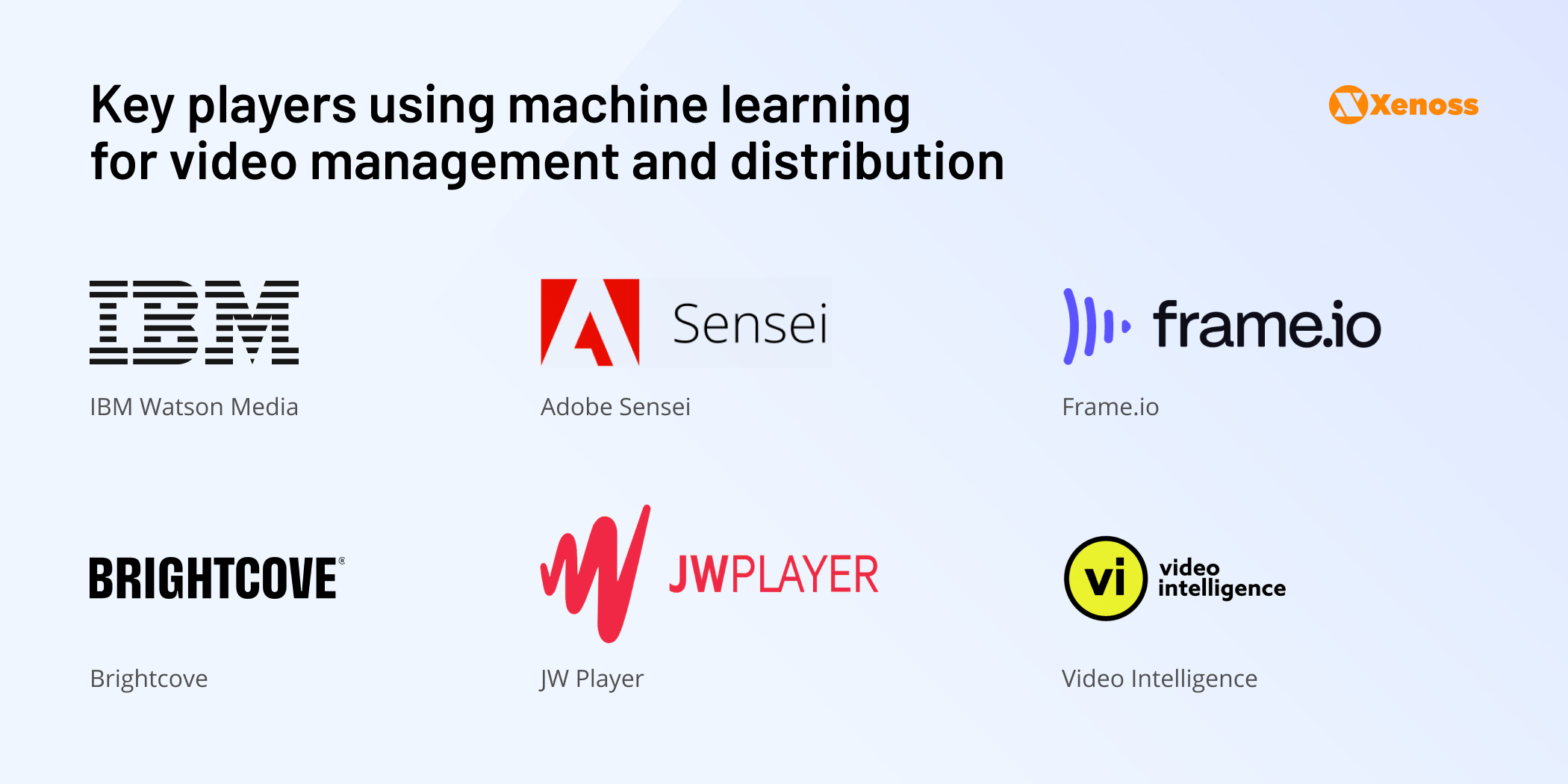
AI is revolutionizing video production and management by automating and enhancing workflows, from the initial creation of metadata to the distribution and consumption of video content. AI technologies help analyze video content ingested into its cloud-based repository, identify relevant frames, as well as detect text and logos through optical character recognition (OCR).
This deep analysis allows for the automatic tagging of detailed content attributes, which significantly speeds up and refines the process of managing large video libraries.
AI’s role extends into the video distribution phase, improving the quality of content recommendations. AI-driven content analysis yields a richer dataset for each video asset, enabling more meaningful and precise content recommendations while respecting user privacy.
Applications of machine learning in video management and distribution:
- Automated content tagging and metadata generation. Adobe Sensei uses AI to help advertisers label their content automatically, keeping an organized library of creative assets.
- Real-time video content analysis for audience engagement. Brightcove uses machine learning to help advertisers monitor how sensitive the audience is to the ad placement, duration, and frequency.
- Video creation and editing assistance. Frame.io helps creative teams speed up video production by leveraging AI in editing.
Ad fraud
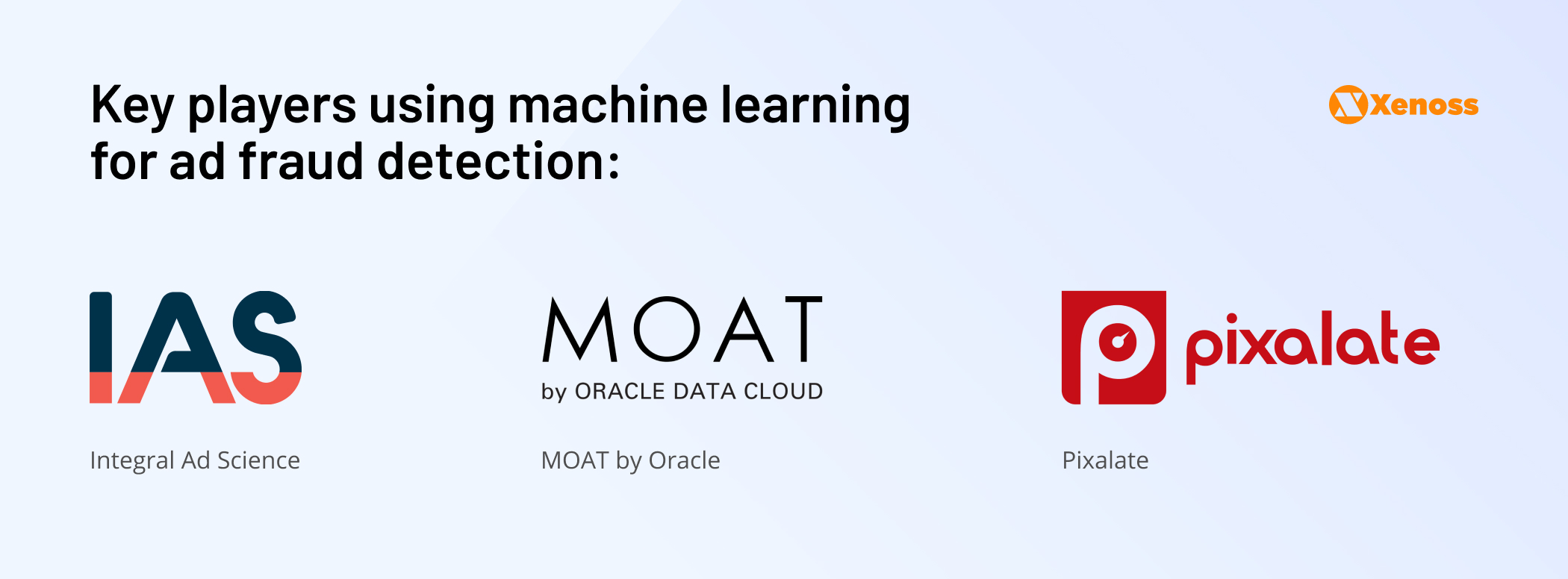
Machine learning is often used to identify anomalies related to ad fraud. Algorithms learn from historical data to spot incoming traffic from atypical locations, abnormally high CTR on ads, or behavior patterns suggestive of bot farms.
Applications of machine learning in fraud detection:
- Ad verification and optimization tools: Integral Ad Science uses machine learning to analyze behavior and context of ad placement to detect fraud.
- Track ad fraud in real time. MOAT by Oracle leverages real-time data to monitor fraudulent activity. The platform’s algorithms analyze traffic patterns to ensure that ads are delivered to genuine users.
- Monitor brand safety and compliance for CTV and mobile advertising. Pixalate offers fraud protection, privacy, and compliance analytics. Their machine learning models are designed to detect and mitigate ad fraud in real-time, across devices and platforms.
Final thoughts
The transformative impact of machine learning and AI on AdTech is undeniable. From automating content creation and optimization to refining targeting strategies and enhancing audience engagement, these technologies are setting new benchmarks for efficiency, accuracy, and innovation in advertising.
As machine learning models evolve, their applications in AdTech are expanding, enabling brands and publishers to streamline programmatic buying, targeting, content generation, and workflow management.
As AdTech vendors become ubiquitous, finding ways to embed AI into their offerings becomes a necessity rather than an option just an option.
To harness the full power of AI in your advertising efforts, hire skilled engineering experts who can guide you through the development process from the architecture to the MVP and ready-to-market product that helps meet business needs and differentiate your offering in an increasingly tight market.
